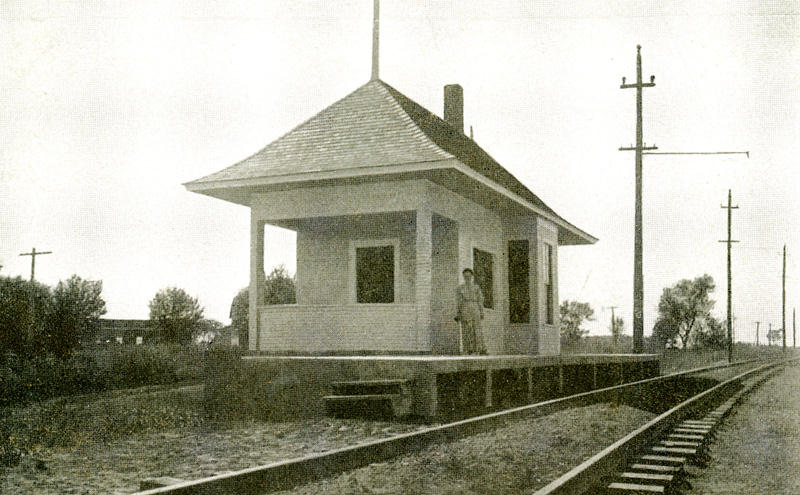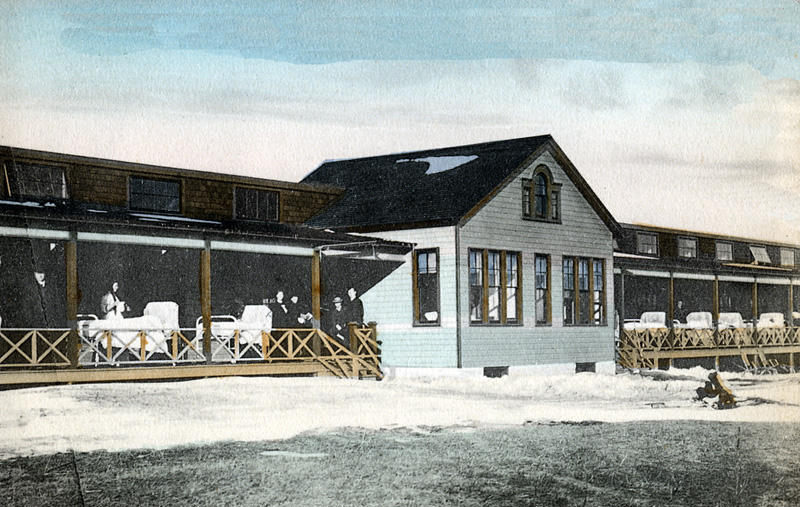| JOHNSON COUNTY IAGenWeb Project |
Copyright 2003
By Bob Hibbs
Saturday May 17, 2003
Saturday
Postcard 194: Oakdale State Tuberculosis Sanatorium
A
treatment philosophy requiring “fresh air and plenty of it” influenced
design at Oakdale State Tuberculosis Sanatorium opened in
February 1908 and recorded by this image which now resides on a postcard in
the Hibbs collection. A nurse tends to a patient buried in bedding.
The white stuff at the base of the building is, indeed, snow.

A
lady in a floor-length dress graces the platform at Oakdale, smallest depot on
the Crandic Interurban Railway route between
Iowa City and Cedar Rapids, in this c1910 image from the Hibbs collection.
Location near University Hospitals on a railroad line was critical factors in
the choice of Oakdale for the state nearly a century ago.
By Bob Hibbs
|
Now State Hygienic Laboratory and incubator park for advanced technology industries, Oakdale was begun nearly a century ago as the State Tuberculosis Sanatorium, an isolation hospital whose site was deliberately chosen to be away from any populated area, yet on a rail line near University Hospitals in Iowa City. Even staff members lived on the original 280-acre farm in state-provided quarters. During one period, all departing postcards were lacquered to encapsulate and thus prevent supposed spread of the tubercle bacillus which causes tuberculosis. The treatment philosophy was based on making the patient comfortable while providing a maximum exposure to sunshine and fresh air, even during Iowa’s harsh winter weather. As the accompanying image suggests, at one time this even included sleeping in beds with snow on the blankets. Although an estimated one-third of the Earth’s population is currently infected with the TB bacteria, the era of tuberculosis epidemic in the U.S. has passed as a result of better public sanitation and improved treatment methods, practices and antibiotic medications. But, in 1908 the fear of TB must have resembled that of SARS today. The disease is ancient, evidenced by its presence in 4,000-year-old mummies and in writing descriptions from ancient Babylonia, Egypt and China. The term dates to 1839 and is derived from the Latin word tubercula, meaning small lump, referring to the small scars seen in tissues of infected individuals. American physician Edward Trudeau thought he was dying from the disease in the 1870s, so traveled to the Adirondack Mountains in New York where he recovered. Attributing his cure to the fresh air of the mountains, he built the first American sanatorium in 1885. It was a model for early building design and treatment at Oakdale. German physician Robert Koch discovered the TB bacteria in 1882. A team of French researchers developed a vaccine in 1924, and American microbiologist Selman Waksman isolated a fungus in 1944 that opened the way to modern antibiotic therapy. Deaths from TB in the U.S. peaked as the Oakdale facility was built at 188 per 100,000 people in 1904. It had declined to 1 per 100,000 by 1980. The Oakdale experience reflects this profile; established in 1908 with eight patients, a major additional structure was erected in 1926 toward an eventual peak size during the 1940s of about 400 beds. Its treatment program was ended and the by-then 497-acre property transferred to the University of Iowa in 1965, and annexed into Coralville about 1968. The Agricultural Medical Research Facility was built at Oakdale in 1966, beginning the university’s expansion of non-TB work there. Oakdale Research Park was created in 1989 on the northern 197 acres of Oakdale. Currently, a $200 million federally-funded project is progressing through the legislative and administrative bureaucracy of Washington DC which is expected to build and staff a world-class hygienic facility at Oakdale as part of the new homeland security program. It would help develop screening methods and treatments for biological agents, as well as working on public defense against such terrorist and public health threats. Meanwhile, Oakdale continues its tradition of offering isolation services. It now functions as the University Hospitals helicopter hangar site, as well as toxic waste storage and transfer facility for biologic and radiation materials generated by hospital and research work. The Iowa prison system’s reception facility receiving all newly-sentenced state felons is located across the highway from the original Oakdale grounds, yet bears its name. The
Crandic Railway still passes the Oakdale door, although its depot has been
gone more than a quarter century. Adjustments have been made. Next
Saturday:
Coralville – mills aplenty! Bob
Hibbs collects local postcards and researches history related to them.
|
